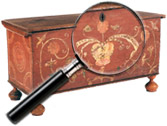|
|
Hoosier and the Hoosier Group
The word “Hoosier” is one of those words whose origins are lost to time. Even The Oxford English Dictionary offers no real guidance about where the word came from. What we do know is that “Hoosier” was first documented in the mid-1820s, and within a decade, it had entered general usage. John Finley, a Hoosier himself from Richmond, write a poem titled, “The Hoosier’s Nest” that was published in [...] Click here to continue reading.
Sitting Bull, Sioux Chief (circa 1831 to 1890)
Sitting Bull, the man who would later become the Hunkpapa Sioux chief, was born in South Dakota, near the Grand River. His Lakota name was Tatanka-Iyotanka. In his thirties, he began to build his reputation as a warrior, leading war parties in Red Cloud’s War against a number of Dakota Territory forts. Although the U.S. negotiated with the Sioux in order to end the war and [...] Click here to continue reading.
Apocryphal – Definition
Apocryphal, the adjective form, means “of doubtful authenticity,” according to Merriam-Webster’s online dictionary. Apocrypha, the noun form, means “writings or statements of dubious authenticity,” again according to Merriam-Webster.
Apocrypha is actually a Greek word that means something closer to “obscure” or “hidden away.” The original meaning of the word, the Apocrypha in the proper noun sense, refers to religious texts outside of the traditional or accepted religious canon. Through connection with [...] Click here to continue reading.
Cassolette
“Cassolette,” the diminutive form of the French word “cassole,” means small container. While the word has other meanings, in the world of decorative arts, it refers to a small covered vase meant to hold perfumed substances or incense. A cassolette normally has holes pierced in the shoulders and in the cover to allow the scent to drift out. Frequently, mounted vases that were not originally designed as cassolettes have had a pierced metal [...] Click here to continue reading.
Ormolu
Ormolu, an 18th-century English term, is from the French phrase or moulu, with “or” indicating gold and “moulu” being a form of an old French verb moudre, which means “to grind up.” (This French term for this technique is bronze dore.) This idea of “ground-up gold”refers to the production process of ormolu, where high-quality gold is finely powdered and added to a mercury mixture and applied to a bronze object. Modern usage often [...] Click here to continue reading.
Mills Restaurants, Ohio
J. O. Mills, a native of Marysville, Ohio, found very little good, home cooked food while on the road in his early career as a traveling salesman. To meet that need, and utilizing his background in hotel and restaurant accounting. Mills opened a small restaurant in I 915 in Columbus, Ohio, and put into practice his primary concept ‘good food at a moderate price’. The popularity of this restaurant led him [...] Click here to continue reading.
RumRill Pottery
While not as famous as the Roseville, McCoy, or Hill potteries, perhaps due to its shorter lifespan, RumRill Pottery still played an interesting role in the rich history of Ohio potteries that sprung up during the late 19th and early 20th centuries and has a story filled with twists and turns.
In 1930, George Rumrill, a Texan with a flair for sales, started a company in Arkansas to sell various art [...] Click here to continue reading.
Shimuel Timmerman, potter
Shimuel was a man of the times. He was a Justice of the Peace, fought in the Creek Indian War, and was a Confederate soldier. His only sibling, John, died as a POW at Camp Douglas, Illinois. His two sons continued to run the business after their father passed on. He is buried at the Wayfare Primitive Baptist Cemetery, Cow Creek, Echols County, Georgia. (Information provided to p4A by a granddaughter [...] Click here to continue reading.
Herend Porcelain
The Herend Porcelain Manufactory was started in 1826 in Hungary by Vince Stingl, he started by making earthenware pottery, but by 1839, went bankrupt and his creditor Mor Fischer took over the factory. Fischer started artistic porcelain manufacturing in this year. Herend subsequently became very successful, being popular with much of the European aristocracy and nobility. His sons took over the operation in 1874 and the company continues to produce fine hand-crafted [...] Click here to continue reading.
Brother Thomas Bezanson
Brother Thomas Bezanson was a Canadian-born artist who is best known for his finely thrown porcelain vessels and complex glazes. After studying philosophy at the University of Ottawa, he spent twenty-five years as a Benedictine monk at Weston Priory, Vermont, before becoming the artist-in-residence at Mount Saint Benedict in Erie, Pennsylvania. Bezanson believed in art as the language of the spirit, and he approached pottery as a monk would their daily [...] Click here to continue reading.
|
Recent Articles
- Charles Alfred Meurer – American Artist & Tromp L’Oeil Artist
- Sendak, Maurice – American Artist & Writer
- Godie, Lee – American Artist
- Davis, Vestie – American Artist
- Bartlett, Morton – American Artist
- Mackintosh, Dwight – American Artist
- Evans, Minnie Jones – African-American Artist
- Mumma, Ed (Mr. Eddy) – American Artist
- Nice, Don – American Artist
- Savitsky, John (Jack) – American Artist
- Gordon, Harold Theodore (Ted) – American Artist
- Dial, Thornton – African-American Artist
- Doyle Sam – American Artist
- Johnson, Lester Frederick – American Artist
- Finster, Howard – American Artist
|
|
